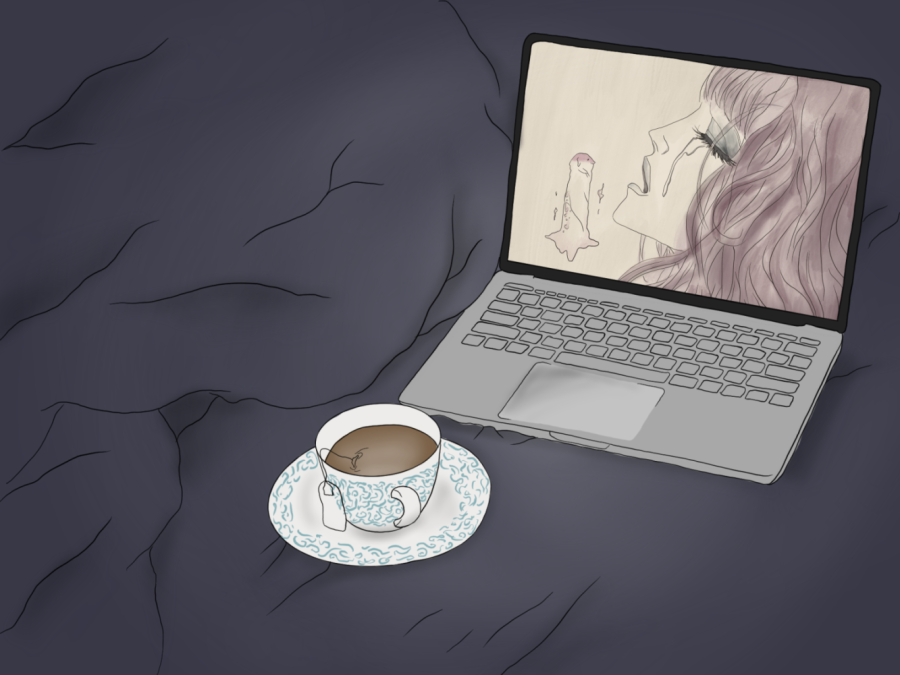Off the Radar: ‘Belladonna of Sadness’ paints a vivid feminist nightmare in watercolor
Off the Radar is a weekly column surveying overlooked films available to students for free via NYU’s streaming partnerships. “Belladonna of Sadness” is available to stream on Kanopy.
“Belladonna of Sadness” is an animated film portraying feudal and patriarchal violence against women. (Illustration by Aaliya Luthra)
October 7, 2022
In Eiichi Yamamoto’s “Belladonna of Sadness” (1973), elegant watercolor vignettes of medieval life — reminiscent of gothic stained glass paintings — are juxtaposed by explosive animated sequences of sexual violence, feudal oppression and moral depravity. Labeled as “exploitative and misogynistic” by some contemporary critics, the controversial film is an unapologetically visceral illustration of the historical brutality and injustice faced by women.
This film is very difficult to process; it leaves viewers awestruck by its unique cinematic artistry, but at the same time, disturbed by gratuitous scenes of trauma. Despite the film’s many discomforting visual and narrative elements, Yamamoto’s thesis is a treatise on female liberation and a harsh denunciation of patriarchal tradition.
Loosely based on the 19th century novel “La Sorcière,” a book that highlights irrational medieval notions of female witchcraft and sorcery, the film follows Jeanne (Aiko Nagayama), the beautiful wife of peasant farmer Jean (Katsuyuki Itô). The couple lives in constant fear under the fief of a cruel Lord and Lady, and endure heavy taxation as well as wanton acts of aggression. In order to gain power, both to support her husband and the rest of the peasant community, Jeanne makes a Faustian bargain with a phallic shape-shifting sprite (Tatsuya Nakadai).
Much like Joan of Arc, Jeanne is a female protagonist who gains agency from the calling of a celestial being; she uses her newfound power selflessly to elevate her husband’s position in court and save the lives of plague-struck peasants. However, just like Joan of Arc, she is threatened by the pride of bitter men and the specter of religious superstition.
Although many scenes are a beautiful symphony of pastel brush strokes, this film is nonetheless an extremely unsettling psychosexual horror show. Along with the graphic and abstract depictions of rape and violence, the illustration of eyes is just as haunting.
The male gaze has never been more intrusive and violating. Whether it is with the intention of lust, jealousy or judgment, the viewer can feel the hostility towards Jeanne at every turn. The piercing looks that the malicious and violent men give are revolting and put the viewer in a deeply vulnerable state.
Viewers can also see Jeanne’s own emotional and psychological progression in her very own gaze. In the opening sequence, she has a bright and naive innocence in her joyful expressions. As the film progresses, however, there is a lifelessness that develops in her eyes as she continues to endure trauma. Jeanne descends into the abyss of sexual depravity, and the audience sees her enter a tortured stupor.
“Belladonna of Sadness” holds nothing back in its portrayal of misogyny. While viewers may be disturbed, or even offended, by the graphic animation, Yamamoto presents a historical precedence of female violence in order to articulate the necessity for a feminist revolution. Jeanne’s story is a history of women under the thumb of feudalism and barbaric patriarchal institutions.
Contact Mick Gaw at [email protected].

























































































































































